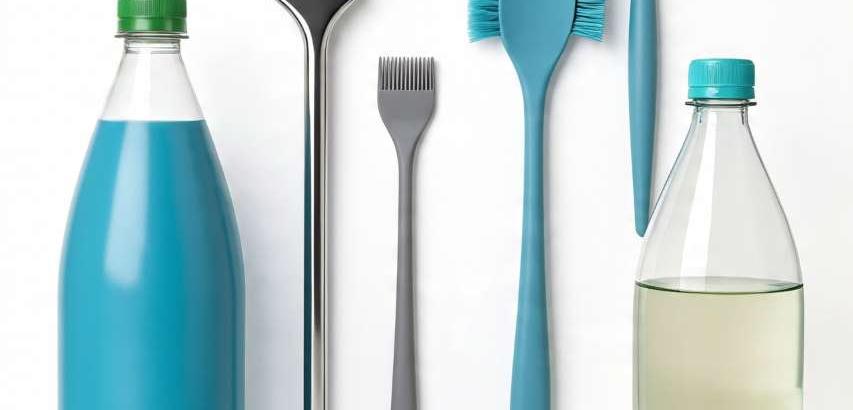Bottle Cleaning Tools are specialized implements designed to effectively remove residue, stains, bacteria, and odors from the interiors of bottles and other narrow-necked containers. Proper cleaning is crucial not only for visual cleanliness but also for hygiene, preventing the growth of mold, mildew, and bacteria that can contaminate liquids. The right tool depends on the bottle type (e.g., baby, sports, water, wine, thermos), the nature of the residue, and the desired level of sanitation.
Categories and Types of Bottle Cleaning Tools
- Bottle Brushes: The Foundation of Manual Cleaning
Bottle brushes are the most common and essential tool. They consist of a handle and a bristled head designed to scrub the interior surfaces.
Classic Long-Handle Brushes:
Description: A long wire or plastic core with bristles (nylon, plastic, or natural fibers) spiraling around it. The handle is typically longer than the brush head to reach the bottom of tall bottles.
Variations:
Tapered Brushes: The bristles taper towards the end, allowing them to fit into narrow necks and then expand to scrub wider bodies.
Angled-Neck Brushes: Feature a bent or angled neck to better clean the shoulder and bottom curves of bottles, which are common spots for residue to accumulate.
Flexible-Stem Brushes: Have a malleable wire core that can be bent to navigate complex shapes, ideal for wine decanters or reusable water bottles with unique designs.
Specialty Brush Heads:
Nipple Brushes: Very small, soft-bristled brushes specifically designed to clean the narrow holes and internal channels of baby bottle nipples and sip cups.
Bottom-Scrubbing Brushes: Feature a cluster of bristles at the tip, perpendicular to the handle, to aggressively scrub the flat bottom of a bottle.
Cleaning Pellets, Tablets, and Powders: For Chemical and Abrasive Action
These are used when brushing alone is insufficient, particularly for removing stubborn stains (like coffee, tea, or protein shakes) and mineral deposits (hard water scale).
Bottle Cleaning Pellets (e.g., Cafiza for coffee bottles):
Description: Small, effervescent tablets or powders containing oxidizing agents, detergents, and sometimes mild abrasives.
How They Work: They are dropped into a bottle filled with hot water, where they fizz and dissolve, creating a chemical solution that breaks down oils and residues. Soaking followed by a rinse is often enough, though a light brushing may be added.
Abrasive Agents:
Description: Common household items like uncooked rice, coarse salt, or baking soda.
How They Work: Added to the bottle with water and a little dish soap, then shaken vigorously. The granules act as a mild abrasive, scouring the interior surfaces as they swirl. This is highly effective for stuck-on particles.
High-Tech and Electric Cleaners
For those seeking a hands-off or ultra-sanitary approach.
Ultrasonic Cleaners:
Description: A small countertop appliance filled with water. The bottle (and a cleaning solution) is submerged in the tank.
How They Work: The machine generates high-frequency sound waves that create millions of microscopic bubbles in a process called "cavitation." These bubbles implode against the surface of the bottle, blasting away contaminants from every angle, including tiny crevices brushes can't reach. This is the professional standard for thorough, brush-free cleaning.
Steam Sterilizers:
Description: While often used for sterilization after washing, steam cleaners can also help loosen grime. They blast high-temperature steam into the bottle, killing germs and dissolving residues.
- Drying and Storage Tools
Proper drying is a critical part of the cleaning process to prevent mildew.
Bottle Drying Racks:
Description: Specially designed racks with pegs or stands that hold bottles upside down to allow for complete air drying.
Importance: Drying bottles right-side up can allow water to pool at the bottom, creating a moist environment where bacteria and mold can grow.
Best Practices for Effective Bottle Cleaning
Rinse Immediately: The single most effective habit is to rinse the bottle with water immediately after use. This prevents residues from drying and sticking to the sides.
Use Hot Water and Soap: Combine your chosen brush or method with hot, soapy water for the best results. The heat helps break down oils.
Don't Forget the Neck and Cap/ Lid: The bottle neck, threads, and the cap itself are prime areas for bacteria buildup. Use a small brush or a toothpick to clean these areas thoroughly.
Sanitize Periodically: For baby bottles or when someone is ill, periodic sanitization is recommended. This can be done by boiling bottles in water for 5-10 minutes, using a steam sterilizer, or using a mild bleach solution (followed by thorough rinsing).
Inspect for Damage: Regularly check bottles and brushes for signs of wear. Scratches on the interior of a bottle can harbor bacteria, and a worn-out brush will be less effective.
Tool Selection Guide by Bottle Type
Baby Bottles: A set including a standard tapered bottle brush, a small nipple brush, and a drying rack is essential. Regular sterilization is key.
Reusable Water/Sports Bottles: A long, flexible brush with an angled head is ideal for reaching the bottom. For stainless steel bottles, avoid overly abrasive pads that can damage the finish. Cleaning pellets are excellent for removing odors from plastic bottles.
Glass Bottles (Wine, Oil, etc.): A sturdy, long-handled brush is necessary. For decanters with complex shapes, a flexible-stem brush or ultrasonic cleaner is the best solution for removing wine stains.
Thermoses and Travel Mugs: A brush with a large, flat head is needed to scrub the wide bottom. A small brush is also required for the lid's mechanisms.
Bottle Cleaning Tools transform a potentially difficult and unsanitary chore into a simple, effective routine. From the humble brush to advanced ultrasonic technology, these tools ensure that bottles are not just visually clean but truly hygienic. Investing in the right tools and establishing a consistent cleaning protocol is essential for health, especially when used for babies, food, or beverages.
 |  |  |
 |  |  |
